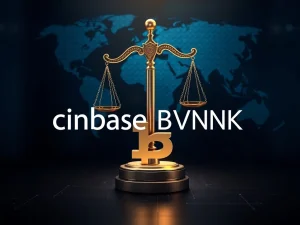Critical Threat: What is a Crypto Supply Chain Attack and How to Prevent It?

The world of cryptocurrency is exciting, but it also comes with unique risks. One of the most insidious threats isn’t always a direct attack on a blockchain or smart contract itself, but rather on the third-party components crypto projects rely on. This is known as a crypto supply chain attack. Are you sure the software you’re using or building with is safe?
What is a Crypto Supply Chain Attack?
A crypto supply chain attack targets external elements that a project uses, rather than the project’s core code. Think of it like poisoning the ingredients before they even get to the kitchen. These external dependencies can include software libraries, APIs, development tools, or even hardware components used in decentralized applications (DApps), exchanges, or blockchain systems.
Attackers compromise these third-party elements to insert malicious code or gain unauthorized access. For example, they might alter a popular open-source library used across many DeFi platforms. Once developers integrate the compromised version, the attacker’s malicious code can steal private keys, redirect funds, or disrupt operations. The heavy reliance of the crypto ecosystem on open-source software and interconnected services makes it particularly vulnerable to this type of attack.
Weak entry points often include:
- Compromised Node Package Manager (NPM) or GitHub dependencies.
- Tampered hardware wallets or SDKs during manufacturing or updates.
- Breached third-party custodians or oracles manipulating data or access.
Did you know? Attackers sometimes host clean code on platforms like GitHub but publish malicious versions to package managers like PyPI or npm. Developers trusting the GitHub repo might unknowingly install risky, altered software.
How Do These Attacks Work?
Understanding the mechanics of a crypto supply chain attack helps in recognizing and mitigating the risk. Here’s a typical breakdown:
- **Targeting a Component:** Attackers identify a widely used third-party component that many crypto projects depend on.
- **Compromising the Component:** They tamper with it by inserting malicious code. This could involve hacking a repository, distributing a fake package, or modifying hardware.
- **Unknowing Adoption:** Crypto developers or platforms integrate the compromised component without realizing it’s been altered. Automated processes and trust in sources allow the attack to spread quietly.
- **Exploitation in Use:** Once active, the component performs harmful actions like stealing keys, redirecting funds, or manipulating data when users interact with the affected application or protocol.
- **Broad Impact:** If the component is widely used, the attack can affect many users and platforms, amplifying damage before detection.
- **Detection Challenges:** The breach is often found only after significant losses occur. Recovering funds is hard due to the nature of blockchain transactions and attacker anonymity.
Did you know? Many attackers use Telegram bots to receive stolen data like seed phrases or API keys. It’s stealthy and hard to trace, which is why Telegram often appears in crypto hack reports.
Real-World Examples of Supply Chain Attacks in Crypto
Examining past incidents reveals attacker methods and provides crucial lessons for enhancing blockchain security.
- **Bitcoinlib Attack (April 2025):** Malicious packages posing as updates were uploaded to PyPI, targeting the Bitcoinlib Python library. These packages replaced a command-line tool with a version that stole private keys and wallet addresses, sending data to attackers. Detection via machine learning prevented wider harm. This highlights the danger of typosquatting.
- **Aiocpa Long-Term Exploit (September 2024):** A PyPI package, initially legitimate, introduced hidden code in a later version (0.1.13) that stole sensitive info like API tokens and private keys, sending it to a Telegram bot. The malicious code wasn’t in the GitHub repo, bypassing standard code reviews until machine learning tools detected it. This emphasizes the need for continuous dependency monitoring.
- **@solana/web3.js Attack (2024):** Attackers compromised versions 1.95.6 and 1.95.7 of this widely used JavaScript API for Solana. The goal was to steal user information from projects depending on the package, which had thousands of dependents and hundreds of thousands of weekly downloads. This showed that even trusted, high-profile packages are targets.
- **DNS Hijack of Curve Finance (2023):** While not a code dependency attack, this is a form of supply chain compromise. Attackers hijacked Curve’s domain registrar account, altering DNS records to redirect users to a fake site. Users interacting with the spoofed frontend unknowingly approved transactions that drained their wallets. This showed that centralized web services are critical weak points for DeFi security.
Did you know? Dependency confusion is another supply chain trick where attackers upload fake internal package names to public registries. If a system installs the wrong version, attackers get a backdoor into crypto applications.
How Supply Chain Attacks Impact Crypto Projects
These attacks cause significant damage beyond just code compromise:
- **Loss of Funds:** Direct theft of private keys or redirection of transactions leads to financial losses for users and platforms.
- **Reputation Damage:** A security breach erodes trust. Projects seen as unsafe lose users, investors, and partners, harming growth.
- **Legal Issues:** Breaches, especially those affecting user funds, attract regulatory attention, potentially leading to legal consequences or compliance audits.
- **Service Disruptions:** Attacks cause technical problems, forcing platforms to pause operations, revert code, or issue urgent fixes, slowing development.
- **Broader Ecosystem Impact:** If a widely used component is compromised, the attack can spread across multiple projects, amplifying damage throughout the crypto ecosystem.
Essential Steps to Prevent Crypto Supply Chain Attacks
Given their indirect nature, preventing these attacks requires proactive measures across development and operations. Improving software supply chain security is key.
Here are key practices to protect your project:
- **Code and Dependency Management:**
- Use dependencies only from trusted, verified sources.
- Lock package versions and check file integrity with checksums.
- Regularly review dependencies, especially those accessing sensitive functions.
- Remove unused or outdated packages.
- **Infrastructure Security:**
- Secure CI/CD pipelines with strict access controls and multifactor authentication.
- Use code signing to confirm software build authenticity.
- Monitor DNS settings, registrar accounts, and hosting services for tampering.
- Employ isolated build environments.
- **Vendor and Third-Party Risk Management:**
- Evaluate the security practices of all external partners (custodians, oracles, etc.).
- Collaborate only with vendors who provide transparency and disclose vulnerabilities.
- Have backup plans if a vendor is compromised.
- **Community and Governance Vigilance:**
- Build a security-conscious developer community through peer reviews and bounty programs.
- Promote open-source contributions but maintain transparent governance.
- Educate stakeholders about new attack methods and response procedures.
By implementing these strategies, you can significantly reduce the risk of a crypto supply chain attack and protect your project and users.
Conclusion
Crypto supply chain attacks represent a significant and evolving threat to the cryptocurrency ecosystem. They exploit the interconnectedness and reliance on external components that define modern software development, including blockchain security and DeFi security. While the core blockchain may be immutable, the layers built upon it are vulnerable. By understanding how these attacks work, learning from past incidents, and implementing robust security practices for software supply chain security, projects can build greater resilience. Vigilance in dependency management, infrastructure security, vendor assessment, and community awareness are not just best practices; they are essential defenses in safeguarding the future of decentralized finance and the broader crypto world. Stay secure, stay informed.







